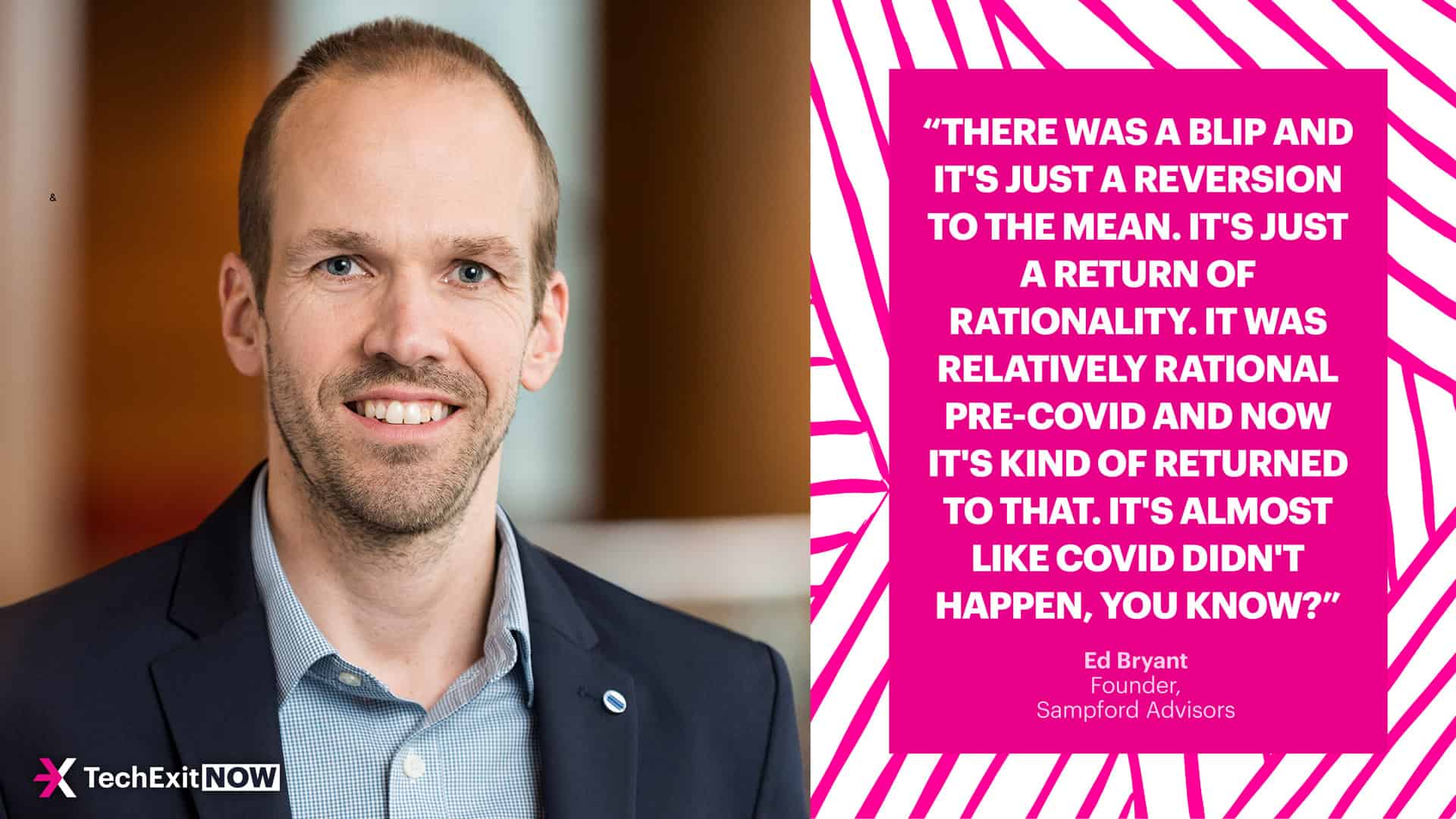Why 2023 Will Be The “Return To Rationality” For Tech M&A
Stefan Palios

The intensity of M&A over the past two years simply couldn’t go on like it was—and sure enough, VC funding has dropped to all-time lows and more companies are going for fire sales or declaring bankruptcy. But Ed Bryant, founder of Sampford Advisors, explained to TechExit.io why he thinks 2023 is more a return to rationality than a crash in the making.
Key takeaways:
- We’re seeing more dramatic failures because there was significantly more VC investment that has now suddenly become skittish.
- While a drop in VC funding can hamper some M&A activity, the market is healthy, said Ed, and more reminiscent of 2019 than 2008.
- Founders selling their company should focus on their tech assets, while buyers need to focus on the build-vs-buy equation.
After the scorching hot fundraising and acquisition market of late 2020 and early 2021, it’s easy to feel disappointed or uneasy about how things went in late 2022. However, Ed Bryant, founder of Sampford Advisors, has multiple reasons to maintain a positive outlook on the tech M&A market. Speaking with TechExit.io, Ed shared the factors that lead him to believe we’re headed for a “healthy market” next year.
Ditching growth at all costs is healthy
For years, startup mantras all amounted to a simple belief that growth was the cure for all startup problems and should be pursued at any cost.
Then came the COVID-19 pandemic. But not in the way you think.
In short, venture capital investment had been steadily growing from around 2010 to 2019. That meant, broadly speaking, if you pursued growth there would always be more capital for the next round. Ed said this meant startup founders didn’t need to think about cash flow much. What changed with the pandemic was capital became even more available at even higher multiples in late 2020 and throughout 2021 as cheap debt became common and governments pumped money into the economy.
“It’s distorted growth,” said Ed. “It's not real growth. It's been funded by companies losing a lot of money in the interim to get that growth.”
Now, investors want to see more balance of growth and profitability (or a path to profitability).
“We created a lot of these companies that are now coming to market because they're going back to the VCs. And the VCs are saying, ‘I don't want to fund that. I'm not writing another check for that. You haven't lived up to expectations,’” Ed continued.
While this might initially seem like a downfall, Ed said it actually looks more like 2019 than 2008 when you think about deal numbers and valuation multiples.
Ed said that the pandemic amounted to almost 10 years’ worth of business in two and a half years, a wildly unsustainable pace that everyone knew simply could not go on. So while there has been a dip from COVID-highs, the numbers pan out: in 2019, there were around 100-120 M&A deals per month in Canada. During COVID, it went up to around 190 deals per month. Now, it’s back “down” to around 120 monthly. And for companies with strong growth and profitability in particular, the market has always been—and still is—active.
“It's not super hot, obviously, but it's not as bad as some commentators are saying,” said Ed. “There's still a very healthy market out there and we expect it to continue that way.”
How to make any deal work for your startup
As a founder, you are likely falling into one of two camps: the growth-at-all-costs company that needs to figure out something asap or the heads-down company that’s got some traction and might be looking to take advantage of the chaos.
Both types of companies have opportunities in this market, said Ed.
For sellers—that is, founders who need to exit because they can’t find capital anymore—the key, said Ed, is to focus on technology. Ed recommended assessing whether you’ve got better technology than a competitor because that could be your opportunity.
“You might be doing $1 million or $2 million of revenue, but for that big competitor to build a competing solution, it will take them two years and $20 Million,” Ed explained. “That could lead to a very good outcome. You sell the business for $20 million and that buyer has it today.”
For buyers, Ed said the build-versus-buy equation might be tipping in your favour. For new features or even whole products, it might now be cheaper to buy an entire company than to build it yourself, to say nothing of speed to market.
“The ‘buy’ is more attractive than the ‘build’ compared to 12 months ago when the ‘build’ was a lot cheaper than the ‘buy,’” said Ed.
Ed added that for any company thinking of buying a business, not just technological assets, you have to pay attention to the company’s unit economics and customer retention. If you buy an asset that gives you features but also a financial headache, it could drag you down.
“Are they retaining their customers? That speaks a lot,” said Ed. “That says their product is good, their team is good. They're doing a good job servicing the customers.”
The return of rationality
If you’d asked Ed for his opinion in the summer of 2022, he admits he likely would have given a more negative answer. But now, his view is changing. He explained that things were quiet in the summer, bucking the recent trend of summers being a relatively busy M&A season. But the last few months of 2022 have seemed more “business as usual,” said Ed.
“There was a blip and it's just a reversion to the mean,” said Ed. “It's just a return of rationality. It was relatively rational pre-COVID and now it's kind of returned to that. It's almost like COVID didn't happen, you know?”
BACK








